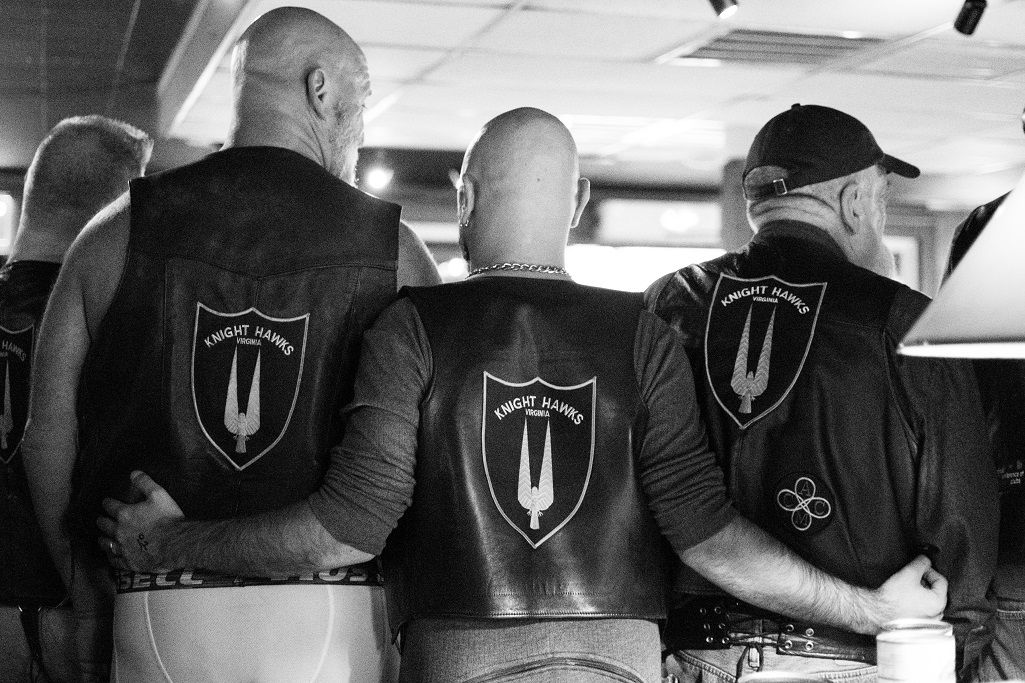*This article comes to us from our sister site, GayRVA.com. It originally appeared in RVA Mag #35, on the streets now at all your favorite spots.
March 1993. People were celebrating St. Patrick’s Day and the coming of passover. Buick LeSabres were stuffed with families in spring photo-op attire. But for three Norfolk friends in particular — Chuck Walrick, Jim Nelson, and Carlos Rhone — the beginning of spring meant a different kind of celebration. They drove from their Tidewater hometowns to Richmond for the annual “Vernal Arousal,” a weekend retreat catering to a crowd far removed from the shopping-mall mainstream.
The event celebrated the fetish community, offering one of few places in the mid-Atlantic in its time where merry kinksters could gather and explore fantasies in a communal setting. Walrick, Nelson, and Rhone shared a fetish for leather, both for the joy of sporting it in public and its properties of sexual enhancement.
Long after they returned to Norfolk, memories of the Vernal Arousal stuck with them, inspiring ideas for a leather fetish club of their own. The stigma around the gay community in the early nineties, amid the HIV/AIDS crisis and the rise of evangelical-conservative politics, made them hesitant. But the friends knew they couldn’t wait another year for the next event. They needed a beacon in the small community of Hampton Roads. They needed a group of their own.
“We threw around a couple names,” Patrick Harvey tells me from the dining room of his Norfolk flat. “Carlos came up with Bay Hawks — but [we thought] people might associate us too much with San Francisco.”
Harvey was Rhone’s partner at the time of the club’s inception, and remembers every detail of their first days.
“Someone chimed in, saying, ‘Hey, we’ll be Knight Hawks In Leather’ — based on a porn movie at that point,” he continues. From one of the binders he keeps next to alphabetized DVDs and assorted change jars, he slides out an old sheet of paper. On it, the original illustration of the club emblem — a rough sketch of the grill insignia from a ‘62 Studebaker Hawk.
“So that’s how our name got its start — a car that no longer exists and a porn film.”


Today, Harvey is president of the Knight Hawks leather club. He’s also their last original member, but his advanced age doesn’t impede his work. He can trace back nearly any photo of past events with precision and an anecdote, and reads the club’s archived ledgers like Sunday comics.
We met in the dining room of Harvey’s first-floor flat in downtown Norfolk. Lining the walls were bookshelves packed with assorted trinkets, photos fuzzy behind glass, and a vast assemblage of leather — mainly vests and belts — hung about, as did the smell.
At age 67, Harvey is a leatherman of legend. He tells me his involvement in the leather fetish community started in the seventies, as the “Castro clones” in the West and old-guard bureaucrats in the East clashed for control of the gay image; the ensuing cultural change took the leather scene to the height of visible gay culture. Harvey preferred the sleek black leather and militaristic caps of the leather fatigues, so he fell into the group with Rhone. He attended the Knight Hawks’ formation meeting — one of the original eighteen.
The Knight Hawks weren’t well received in the Norfolk community. Many thought they would amount to little more than their predecessors, the Wildcats, a defunct club notorious for wandering the mid-Atlantic in the eighties like a nomadic party tribe, engaging in acts of debauchery in each town they rode into. “We were fighting against the Wildcats to maintain our own image, fending off the latest tales of ‘What did they do this week in D.C.?’” Harvey said.


The Knight Hawks spent much of their history struggling to provide their club with the most basic structural elements. “Without the confines of a bar, it’s really hard to organize. It’s almost impossible,” Harvey tells me. But when the Knight Hawks started, gay bars were under a much greater degree of scrutiny than they are now, and the concerns of a niche club weren’t on owners’ radar. The lack of a home made events difficult to set up for many years. They finally found their current base of operations, at MJ’s in downtown Norfolk, five years ago. It was a long time coming.
Today the group has 30 members and is still growing. They’re always excited to bring in members, but they don’t accept just anyone. After being awarded their “cut” (a club jacket with identifying patches), active members vote on issues and have to stay involved with most group activities. Yet the club has twice as many “associate members.” There’s a good reason for that.
“You have to think back,” Harvey said. “1993 was still in the days of don’t ask, don’t tell, so there were some people active in the military who were inquiring but didn’t want to be associated with what was essentially a gay organization. So to be an ‘associate member’ gave the option for them to be involved, but not actively appear on a piece of paper.”
The military connection to the gay community isn’t well-known, but it definitely exists — and in a military city like Norfolk, it’s unavoidable. Around a third of the club’s members are, or have been, in the military, and many are still uncomfortable exposing their names to the public. Jim Farmer, the club’s current Vice President, knows this quite well as a military spouse. Farmer has been an active member since 2011, and has provided a complement to Harvey. Harvey kept his partying within state lines, but Farmer has traveled far and wide, attending massive leather events with attendance in the thousands, from San Francisco to Berlin.


As VP, Farmer is the gregarious face of the club. He chats up guests and newcomers on bar nights, and has started posting on Instagram. Farmer says he came out when he was 13, but thinks of his entrance into the group as passage into his own skin. “Knight Hawks gave me permission to talk to people I normally would never get to,” he said.
For most, leather has a strictly-practical use, as protective clothing for physical labor. But, in tandem with the rugged lifestyle and well-structured club functions behind biker culture, it created an undeniable allure. “The bikes were interesting, but it was really the riders that made the look,” Harvey tells me.
For young gay men in the 70s, leather was a rejection of the pressure to conform to the “sweater queen” stereotype that cast gay men as well-to-do, preppy types. In a time when the LGBTQ community had to choose between abiding by the stifling image they were given and being invisible, the leather men set out to reclaim the masculinity these stereotypes denied them.
Then came a crisis: In 1981, the New York Times reported a “rare cancer spotted in 40 homosexuals.” Public sentiment quickly turned against the LGBTQ community. The leathermen were some of most visible and outspoken, so they were the first to go. Entire communities were eliminated. A later report cited the first AIDS-related death as Tony Tavarossi, founder of San Francisco’s first leather bar.
In a time of loss, Harvey survived — partly because, in the midst of the chaos, keeping the Knight Hawks alive as many other leather clubs disappeared provided a much-needed focus.
“We lost so many people in the early days of the HIV phenomenon. Not a lot of people my age are around still to tell the tale of ‘this is what we did, and this is what happened to us,’” Harvey said.
For many in the leather community, leather fetishes denote not only an aesthetic, but certain sexual practices that go along with it. For an entry-level fetishist, this might just look like getting your rocks off in a well-cut bomber. But for the more committed, it’s a full look. Boots, trousers or chaps, belts, shirts, jackets, overcoats, captain’s hats: All in premium black leather. Each accessory has a place within a certain school of thought.
“There are two trains of thought,” said Farmer. “One is the old school traditional, where there are rules about how you wear certain outfits, what’s appropriate, what you’re projecting. If you’re a dominant sir, then you’re gonna wear a certain outfit; if you’re projecting a submissive type, then you’re outfitted in a… different way.”


The gay leather scene traditionally catered only to men, but that is gradually changing. “Back then, when you went to a leather bar, there was a dress code, there was a certain behavior code and women weren’t allowed in that environment,” said Farmer. “Well okay, guess what — those bars aren’t around anymore.”
While only three women have ever been involved with the group, one in particular stuck out in Farmer and Harvey’s minds for her commitment to the culture. “We had an African-American young lady — Aisia Jones,” said Farmer. “I was borderline rude to her: ‘Why do you want to be a Knight Hawk?’ There were no women at that time.”
Jones’s first entry into the leather scene was with the Knight Hawks. Originally from San Diego, she followed her husband-to-be to Dam Neck naval station in Norfolk. From there, she simply checked out what was available in the area. She pledged in 2011, when the group was in a stagnant period and Farmer was heading overseas. He didn’t include himself in the vote to admit her into the club. “I wouldn’t give her the time of day,” he said.
It wasn’t until Farmer’s return to the club in 2013 that he saw how Jones had extended her role in the club. “I came back on a bar night and, here’s Asia in her Knight Hawk full colors, selling Jell-O, out in the community, showing and being proud of being a Knight Hawk,” he said.
Her leather outfits were certainly her own — the kind of outfit that turned heads at the bar. “I think it was great,” Farmer said. “It gave the group a new look that showed they weren’t so closed-off, and that maybe anyone could join the group.”


Jones returned to San Diego in 2014, and immediately sought after the leather competition circuit. Her first title — Ms. Alameda Leather — came in 2016, and in 2017 she won the International Ms. Leather competition in Chicago, entering both as a Knight Hawk.
Jones says that while she did have to put on the usual dog- and pony-show on the competitive circuit, she was able to use the platform to slide in some serious topics — like black intersectionality in the fetish community. “I let them know that… especially during this intense political climate, you might want to open up your space to other marginalized people,” she said. “That’s how we survive and thrive — because we’re all we have.”
Farmer later visited her at the San Francisco Eagle during Folsom Festival, where he found her wearing her full Knight Hawk colors representing the small club back on the East Coast.
She’s proud to do so.
“For me, to be a Knight Hawk is to be a part of a legacy that started before me, and help own the torch of this little club in Norfolk, Virginia, of all places.”
Today, Jones still sports her IMSL belt with a vest and a leather t-shirt. She remains the only fully-patched female member of the Knight Hawks, wearing their patch alongside her title patches. For those in the know, it’s just as much of an attention-grabber. “Someone stopped me in the crowd and exclaimed, Knight Hawks of Virginia, really?!’” she said. “For me, it’s like being a part of a really cool family that only a few people know about, and have nothing but love and respect for it.”



